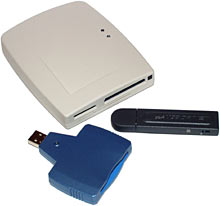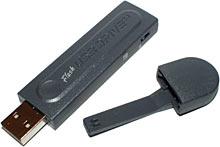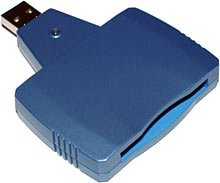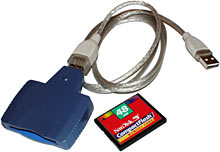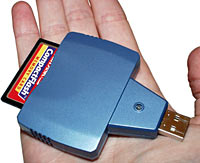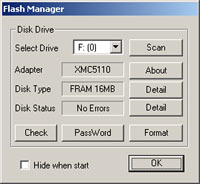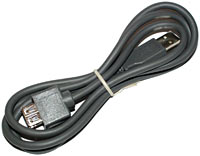
Flash memory storage device comparison
Review date: 8 June 2001.Last modified 03-Dec-2011.
Non-volatile RAM is finally starting to become a decent general purpose storage medium.
It's always had big things in its favour, mind you. "Flash RAM" storage devices are shockproof (well, at least as shockproof as the average digital watch, anyway), dustproof, immune to magnetic fields, and really small, too. That's why flash memory cards - mainly in the popular CompactFlash and Solid State Floppy Disk Card (SSFDC, mercifully usually referred to as SmartMedia) formats - are used in digital cameras and MP3 players and palmtop computers for storage. They hold data without power, just like disk storage systems, but they don't have the same limitations.
The one big problem with flash memory has always been that it's too expensive. Something like one to two hundred times as expensive per megabyte as hard disk storage.
Well, flash RAM is still a very great deal more expensive per megabyte than hard drives. But hard drives are a lot cheaper than they used to be. You can now get a memory card with, say, 32 to 128Mb of non-volatile RAM, for about $AU100 to about $AU360.
$AU360 will get you a 30 gigabyte 3.5 inch hard drive and some change, of course. But you can't stick that drive in your pocket, or hang it from your keyring.
You can do that sort of thing with flash RAM, and there are now stand-alone storage devices that are specifically designed for that purpose. Some flash RAM and interface hardware in a case roughly the size of a BIC lighter, with a USB connector on the end.
The JMTek USBDrive is just such a gadget. There are others - the Trek ThumbDrive and the Agate Technologies "Q" drive, for instance. This USBDrive's the basic 16 megabyte model, and it costs $AU125. A 16Mb ThumbDrive from CreativeZone here in Australia is $AU154, for comparison, or a little cheaper from Adelong Computers.
Up against these "key ring drives" in the super-portable-storage market are ordinary memory cards, and USB reader/writers (usually just called "card readers") to suit them. Many readers aren't really pocketable, but some are.
Like this one, for instance, which is sold here in Australia by Flashmemory.com.au as the "FMCF-KEY". It costs $AU74, plus the price of whatever memory cards you want to use with it. A 16Mb card costs $AU85, but larger capacity cards are better value, as we'll see.
And then there are the traditional reader/writers, some of which support multiple card formats. Like this one, also from Flashmemory.com.au; they sell it as the "FMSM-MSCF". It can deal with CompactFlash, SmartMedia and Sony's Memory Stick, and it costs $AU151.
So what's the difference, and what are they all good for?
Glad you asked.
KECF-USB
Flashmemory.com.au call it the FMCF-KEY, but the label on the bottom makes plain that this is actually a Datafab KECF-USB.
The label on the bottom's about the only thing that does make it plain, though. Many memory card reader manufacturers downplay their branding, or have none at all, to make it easy for other companies to onsell their products under some other, usually rather more famous, name.
The KECF-USB's modesty is, however, unnecessary. It's a groovy product.
First off - you can use it as a no-cable pocket-drive. It doesn't have an integrated cable, but instead comes with a USB Type A male-to-female extension lead. Connected to the lead, it behaves like a normal cabled CompactFlash reader. Without the cable, you can plug it straight into a USB port.
The cable-less KECF-USB isn't BIC lighter sized, but its main body (not counting the sticky-out USB connector part) isn't much larger than a Zippo lighter. And it weighs less, too. It's perfectly suitable to be carried around in your pocket.
The shape of the KECF-USB means that you won't be able to use any USB ports on either side of the one you connect it to. But if that's not a problem, you'll be fine. For brief data transfers, you can just yank any other USB plugs out; it's a hot-pluggable interface, after all, and if you only have to unplug something inessential like a webcam or scanner, then it's not a problem.
(I'm informed by a reader that, while Linux kernel versions from 2.2.17 upwards work with standard USB mass storage devices, the current Datafab readers aren't quite as standard as they might be, and don't work. What, exactly, the difference is, I don't know. The Datafab readers are fine without a special driver in Windows. But Linux users who want to avoid the chance of considerable driver-hunting irritation should probably play it safe, and drop a few more bucks on a more standard card drive instead. My correspondent says that his current-model Sandisk Imagemate works fine in Linux.)
The second handy thing about the KECF-USB is that you may not need a driver for it. This is because it's set up as a "USB mass storage device", which means drivers for it are built into various current operating systems. Plug it into a Windows ME, 2000 or XP computer - or, for that matter, an up-to-date Linux or Mac OS box - and you're away.
That's how it worked for me on my Windows 2000 machine. Plug and go. It comes with a driver CD for earlier Windows versions, and MacOS 8.5 and higher; you can also download the appropriate driver for your OS from Datafab here.
The KECF-USB also performed impressively. I tested it by the time-honoured method of just copying a big heap of files to it, restarting the computer to clear the disk cache and then copying them back. It turned in a 970 kilobyte per second read speed, and 365 kilobytes per second for writes.
It's easy to overestimate the write speed of devices like this when you're just copying files to them in Windows, because the operating system uses caching that means the file operation status window disappears some time before the actual write operation concludes. You've got to watch the device activity light - the KECF-USB uses a simple green LED that flickers when it's doing something - and ignore the monitor.
The KECF-USB's write speed is nothing very exhilarating, though it's not bad. The read speed is excellent, and about as fast as you can expect any USB storage device to manage - at least until we see computers and storage hardware that support the much faster USB 2.0 standard.
USB storage device performance can vary greatly depending on the operating system and drivers you're using - and that includes the operating system's drivers for the motherboard USB controller hardware. Some USB oddities in Windows PCs can be cured by connecting a self-powered hub to a motherboard USB port, which stops the motherboard from having to supply power to any bus-powered USB gear you connect. If your PC doesn't have any USB problems, though, and you don't need to be able to read anything but CompactFlash cards, then the KECF-USB looks like a good choice.
And quite good value, too, compared with the next gizmo in this comparison.
JMTek USBDrive
Well, it's certainly not big. Without its pocket-clip cap on it, the USBDrive is only slightly longer than the KECF-USB, but it's far narrower, and very easy to carry around.
This "16Mb" drive doesn't really have 16 megabytes of capacity - it's really got 15.5. But that's just standard operating procedure for storage manufacturers. Non-volatile storage manufacturers, including hard drive companies, like to define a megabyte as 1,000,000 bytes and a gigabyte as 1,000,000,000 bytes. They're actually two-to-the-power-of-20 and two-to-the-power-of-30 bytes, which is 1,048,576 and 1,073,741,824 bytes respectively. This is the main reason why a "20Gb" hard drive won't actually give you 20Gb of capacity.
In flash RAM devices, things can get a bit more complex again, thanks to the small amount of memory which may be used by the device itself for housekeeping. That can vary between device families; a CompactFlash card with a given nominal capacity may actually have a bit less space than a SmartMedia card with the same number on the label. And manufacturers may throw in some more memory to push the real capacity up closer to the stated one, which is what they've done with the USBDrive. It's still about three per cent shy of its claimed capacity, though.
When you're buying a storage device that doesn't let you upgrade its memory - you want more storage, you buy a whole new USBDrive - this capacity shortfall matters more than it does if you're just using memory cards.
Before we start crunching price numbers - is this thing any good?
Well, it's OK. With some reservations.
For a start, about the USBDrive, JMTek say "No cable, no battery, and no software either". Which is wrong.
The USBDrive, despite looking more like a plug-and-go solution than the Datafab reader, actually isn't. It needs a driver, no matter what operating system you use it on.
If the hole in the middle of this CD looks a bit big, that's because the USBDrive is the first product I've seen that comes with its driver software on a 77mm CD-ROM. That's the "CD single" size. This makes it easier to carry the disc around with you, but it's a pain if you want to use it with a computer that's got a slot-load CD-ROM drive. Some slot-load drives work with singles. Some don't. Some can inhale them but not spit them out again. Do you feel lucky?
The driver window lets you do various administrative tasks, and manage multiple USBDrives if you've got more than one connected at a time. By default, this window pops up whenever you connect the drive, but you can tell it not to. There's a little icon in the system tray to access this interface; the icon has a bar graph that shows you how full the USBDrive is.
You don't have to keep a driver floppy with you if you've got Internet access wherever you want to use the USBDrive; you can download the driver (for Win98, WinME, Win2000 and Mac OS 9) from JMTek's page here.
JMTek also say "USB ports allow the fastest data transfer".
Compared with what, exactly?
The USBDrive isn't, of course, very fast compared with a hard drive. No USB device is. But it's not even blindingly fast compared with other USB gadgets. Its read and write speeds were both about 470 kilobytes per second on my Win2000 machine. That's certainly not rubbish, and it's perfectly adequate for pretty much anything that anyone's going to want to do with one of these things, but a blazing speed demon the USBDrive is not.
Like the KECF-USB, the USBDrive comes with an optional extension cable to make it easier to plug the thing in.
There's a little light on the side of the USBDrive that glows green when the USBDrive's ready to go, and turns red when there's a read or write operation in progress.
There's also a pin-switch that lets you write protect the USBDrive. You don't have to unplug the drive to change the write protect status, though if it's connected directly to the back of a computer you're probably going to have to for simple physical reasons. Run the USBDrive at the end of its extension cable and you can just flick the switch at will. The read/write enable status takes a few seconds to change, but it'll do.

Whenever you write to the USBDrive, this odd little window pops up to tell you that you're doing it. And it hangs around for a minimum of 15 seconds, even if you just deleted one tiny file. I'm not sure why.
The USBDrive's status light turns green practically immediately for a small write operation, as you'd expect. But the annoying little always-on-top "Writing" window keeps flashing away.
If you plug and unplug USB things when Windows would rather you didn't, you can tie the USB subsystem up in knots easily enough no matter what device you're frobbing. Sometimes it takes practically no effort at all. But the USBDrive software seems to make strange error messages more common.
Like this one, for instance.
And this one.
And not forgetting this one.
The USBDrive software lets you set an access password, which has to be typed in whenever you plug the USBDrive into the computer, or you can't access the data. JMTek say nothing I can find about the very existence of this feature on their Web sites, including the Australian one here.
This suggests to me that the password system isn't a proper, robust, data-encrypting one, but instead just a tacked-on driver thing. It'd be easy to make the USBDrive store the password in its memory and set a bit that tells the driver "prompt for a password; I'll tell you if it's the right one, and if it isn't, don't allow access". If this is the case, then anybody who hacks up a driver that just doesn't do the check will be able to access your files. It won't stop a serious attacker.
The Trek ThumbDrive comes in a separate and slightly more expensive "Secure" version which I presume has proper encryption built in. Bizarrely, though, they don't seem to say one word about the actual data protection system, either. Their maximum password length is 15 characters; if you use a string that long of random upper and lower case letters and numerals (you know, one of those impossible passwords that nobody can remember) then that's roughly an 89 bit keyspace, and very secure. Provided of course that the data on the ThumbDrive itself is encrypted and it's not another combination-lock-on-a-cardboard-box situation. If you use a shorter or less random password, you get a lot less security.
If you're not keeping million dollar secrets on your portable storage gadget then this isn't a big deal, of course. But if the security systems are trivial to bypass, it's likely that someone will make a free-download cracker for the things some time soon. Bear that in mind before you vote for a law that requires nuclear missile firing keys to be kept on these things.
OK, so is this thing value for money?
JMTek's on-line store sells the 16Mb USBDrive for $US59 ex shipping; 32Mb is $US99, 64Mb is $US159, 128Mb is $US299, and 256Mb is $US559.
Australian pricing for the drives is quite good, compared with the ThumbDrive and Q Drive. The 16Mb USBDrive lists for $AU125, the 32Mb for $AU209, the 64Mb for $AU389, and if you're a big spender that wants 128 or 256Mb then you're looking at $AU749 and $AU1189, respectively.
Compared with something like the KECF-USB plus a CompactFlash card, though, it's less exciting. The USBDrives cost $AU7.81 per pseudo-megabyte for the 16Mb version, and a mere $AU4.64 per pseudo-megabyte for the very expensive 256Mb one.
Now, you'll pay $AU9.94 per not-quite-a-megabyte if you buy an KECF-USB and a 16Mb CompactFlash card from Flashmemory.com.au at the moment, but every capacity level above that is cheaper per megabyte if you go the CompactFlash way. For 32, 64, 128 and 256Mb capacities, respectively, the KECF-USB-plus-card option will save you 38, 133, 312 and 268 Australian dollars, respectively.
And there are more capacities available in CompactFlash cards - 48Mb, 96Mb, 192Mb, and bigger than 256Mb cards as well, if you've got a very fat wallet.
And, of course, you can buy multiple cards to use with a reader. USBDrives aren't upgradable. If you buy a 32Mb USBDrive and then decide you need another 32Mb, you'll have to spend another $AU209. Another 32Mb CompactFlash card is only $AU97. And many people have a CompactFlash card or two anyway, for use with their digital camera or MP3 player or what have you. It's easy to use a card for plain data storage whenever you don't need it for the other gadget.
So, basically, you really need to put a lot of value on getting somewhat smaller size, a write protect switch, and password protection of unknown quality, in order to decide to buy a USBDrive.
On to the three-headed monster.
FMSM-MSCF
What's this thing really called? You got me.
This is one of those Amazing Brandless Taiwanese Products; nowhere on the hardware or in the documentation will you find a printed brand name. It's a "UISMC4" according to its driver software and the sticker on the bottom, and the term "Triple Reader" is used a couple of times. So I'll call it that.
Verbatim Australia list the UISMC4 as one of their products, by the way; there's a perfect example of brandless gear being sold by bigger names.
For $AU151 from Flashmemory.com.au, the Triple Reader seems pretty good value. If, of course, you actually need three memory card drives.
The UISMC4, or FMSM-MSCF, or whatever, is considerably bigger than most single-card readers; it has to be a fair bit wider, just to accommodate the three card slots. But it's still quite slim, considering what it can do.
It connects to the PC with an ordinary USB A-to-B cable, and when you install the driver and plug it in, your computer now has three new removable drives. You have to figure out for yourself which drive letter corresponds to which slot, but that's not a major problem. The driver software works in Windows 98, 2000 and ME, and in Mac OS 8.6 and above.
Well, it kind of works.
This thing reminded me of how USB storage devices used to be all the time in the olden days when Win98 was only just out. Motherboard USB chipsets were often dodgy, OS support was questionable, and drivers were commonly poorly written.
You'd move some files to or from a memory card, and the transfer would be quite quick one way, and really really slow the other, for no obvious reason. Generally, Windows would report something like "15 seconds remaining" for the whole of a ten minute file transfer.
Sometimes, your computer wouldn't start up if the card reader was connected. Or it wouldn't shut down. Or removing a card could hang the computer. Or you had to reboot if you removed one card and inserted a new one, or the new one wouldn't be recognised. That sort of thing.
My Windows 2000 machine wouldn't start up with the Triple Reader connected - though it was OK if I plugged it in after startup. And removing a card hung the drive - the computer kept working fine, but I had to reboot to make that card slot work again.
USB gadgets shouldn't do this sort of thing any more. But this one does.
When I tested the Triple Reader on my Windows 2000 machine with a CompactFlash card, it managed a read speed of about 560k/s, but only 270k/s for writes. With a SmartMedia card, the read speed dropped to 405k/s, and the write speed was barely 230k/s. I didn't have a Memory Stick handy to do a test.
When I tested the Triple Reader on a Windows 98 machine, though, its CompactFlash read and write speeds were 440k/s and 260k/s, respectively. The SmartMedia read speed was faster, now - 510k/s - but the SmartMedia write speed fell to a barely credible 100k/s.
Given the quirky driver performance in other respects, I wouldn't be at all surprised if these numbers varied practically randomly between computers, depending on the particular USB hardware and OS drivers for it.
Maybe an updated driver would solve the problem, but strange nameless manufacturers are not exactly renowned for on-the-ball driver teams, and I'm darned if I know where you'd download the updated driver from anyway.
The Triple Reader probably works absolutely perfectly on some computers - such is the way of flaky USB devices - but it didn't on either of the machines I tried. Caveat emptor.
Overall
The USBDrive could be handy, but it's expensive - especially for larger capacities - needs driver software, and doesn't really have any super features that compensate for those shortcomings.
The Triple Reader gives you three card drives in one box for about $AU50 each, but it doesn't work well enough to be recommendable. If you can try on your system before you buy, it'd be worth a look.
The Datafab KECF-USB, however, I like.
I've been using a Cobra CompactFlash reader for some time now (I review it and its SmartMedia cousin here), but it doesn't have Windows 2000 drivers and never will. So it's sitting on a Win98 machine, networked to my Win2000 one, and I just put up with crummy transfer rates.
The Datafab reader isn't just faster than the Cobra-via-LAN arrangement - pretty much anything would be - it's a bit faster for reads in Win2000 than any other USB CompactFlash reader I've seen. It's handily beaten by the IEEE-1394 Datafab reader I review here, but that's a more expensive reader, and most people don't have a Firewire port to plug it into.
The speed by itself makes the KECF-USB a good choice for someone who wants a card reader for the usual sucking-up-digital-camera-pictures purpose. Its extreme portability, and driver-free operation on modern PCs, is a big plus.
OK, so it's too big to put on a keyring. But it's not too big to fit in a pocket. It weighs very little, and it's every bit as plug-and-go as any ThumbDrive clone - and more so than the USBDrive.
So I recommend the KECF-USB. And I'm going to keep it.
UPDATE: I did keep it, and used it a lot, for almost exactly two straight years of plugging and unplugging the thing several times a week. Now, it's rather unreliable, because its USB connector's worn out. You can't really ask for a lot more than that from a card reader!
KECF-USB and Triple Reader kindly provided by Flashmemory.com.au, who sell to Australian and overseas customers.
